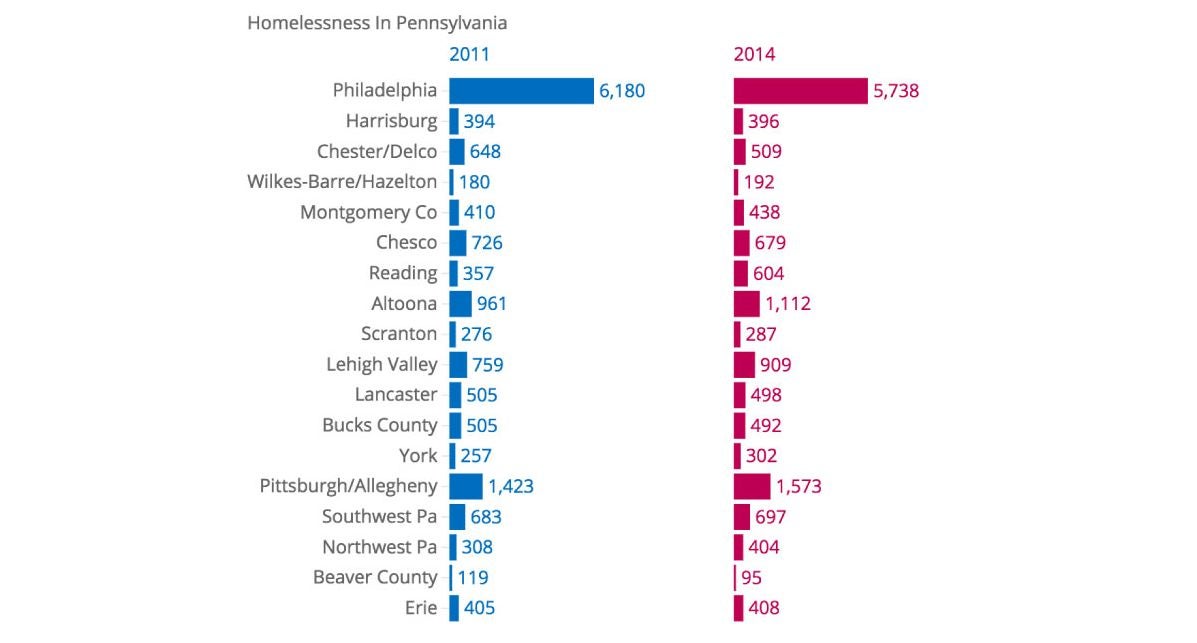Homeless population up in Pennsylvania, down nationally

Data from the U.S. Department of Housing & Urban Development. (analysis by Emily Previti/WITF, graphic by Rachel Feierman/WHYY
The number of people experiencing homelessness increased 1.6 percent in Pa., and dropped 2.3 percent across the U.S. and three territories last year.
Along with Puerto Rico and Washington, DC, just 16 states noted an increase, according to the National Alliance to End Homelessness annual update released recently. But Pennsylvania’s 1.6 percent growth rate ranked second-lowest (to Puerto Rico) of the group.
And the Commonwealth still has relatively few people experiencing homelessness when the state’s general population is taken into account. Nationally, 18 per 10,000 experience homelessness; in Pennsylvania, it’s 12 per 10,000. The state’s rise was driven by people living in emergency shelters or transitional or supportive housing on their own (not as part of a family).
The Alliance based its report on data collected from social service agencies in 50 states, DC, Puerto Rico, Guam and the Virgin Islands by the federal Department of Housing and Urban Development. They get the information by counting homeless individuals in mid to late-January each year.
Known as the Point-in-Time Survey, the initiative is considered to be the most reliable source of statistics on homelessness in the U.S. HUD released its own analysis late last year.
The Alliance’s report notes that the national decline in homelessness fits with changes observed in some related factors – but not all.
Although unemployment rates are dropping, poverty’s relatively flat. And a rising number of households are doubling up and facing severe housing cost burdens, meaning rent or mortgage payments takes up at least half their incomes.
“That tells me the struggle is great,” says Kathy Possinger, who heads Tri-County Community Action. The social services organization covers Cumberland, Dauphin and Perry counties in Central Pennsylvania.
It’s important to consider what types of jobs and pay rates relative to living expenses, if employment nubmers are strong; whether government assistance program guidelines have changes, if participation is down, Possinger notes.
The point being, more informaiton might be needed to gauge how difficult sustaining basic needs might be for vulnerable populations, she says.
Here’s what else the Alliance’s report showed about how Pennsylvania compared to the rest of the nation:
Veterans
Fewer veterans experienced homelessness in 2014 than in 2013 in Pennsylvania (down 3.5 percent) and nationally (down 10 percent).
17 per 10,000 veterans living in the Commonwealth are homeless, compared to 26 per 10,000 nationally.
Families
The number of families that are homeless dropped nationally and in Pennsylvania overall
But chronically homeless families increased nationally (7 percent) and in Pennsylvania (2.3 percent)
Chronic homelessness (three or more instances of homelessness within a year, or one that’s lasted at least a year)
Increased among families, as noted above.
Decreased among individuals who are on their own, and not part of a family unit experiencing homelessness, in Pennsylvania (5.7 percent) and nationally (2.5 percent)
Unsheltered, meaning living in a car, tent, abandoned building or other space social service agencies consider “unfit for human habitation”
Decreased nationally (10 percent) and in Pennsylvania (24 percent)
That population, however, still arguably attracts the most attention of any subgroup tracked by HUD, the Alliance and others.
Keystone Crossroads also analyzed HUD’s localized data on homelessness for a snapshot on the state and cities’ homeless population in 2014:
Veterans
Account for 9 percent of homeless individuals living in Pennsylvania and the U.S.
They account for 42 percent of homeless people living in Chester County*, but that’s skewed by the Coatesville Veterans Affiars Medical Center’s multiple programs for homeless
Next comes Pittsburgh and Northwest Pennsylvania at 15 percent.
Families
45 percent of people experiencing homelessness in Pennsylvania were part of a family unit, higher than the 37 percent national number.
Bucks County (63 percent) and Scranton (59 percent) were higher
Unsheltered
The Lehigh Valley had the highest percentage (15) of unsheltered homeless people, versus 11 percent statewide.
But that was lower than the 31 percent national split.
Chronic homelessness
York was highest (16 percent) versus 10 percent statewide and 15 percent nationally.
Wilkes-Barre/Hazelton counted zero.
How does that compare to 2011, when the first year data was provided by all Pennsylvania regions reporting in 2014?
Homelessness is up 2 percent statewide.
Up most: Reading, by 69 percent
Down most: Chester County, by 21 percent
Veterans
Homelessness among veterans decreased by 3.5 percent in Pennsylvania.
Quadrupled in Bucks County, more than doubled in Reading
Dropped 50 percent in Beaver County.
*Reporting entities are continuums of care, often named for the largest city in the area. The continuums are geographic regions that pool and share resources.
WHYY is your source for fact-based, in-depth journalism and information. As a nonprofit organization, we rely on financial support from readers like you. Please give today.



